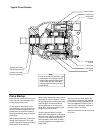
Typical Cross Section
Position inner shaft
seal facing bearing
Position outer shaft
seal facing shaft end
Pump Startup
Make sure the reservoir and circuit are
clean and free of dirt and debris prior
to filling with hydraulic fluid.
Fill the reservoir with filtered oil to a
level sufficient to prevent vortexing at
suction connection to pump inlet. It is
good practice to clean the system by
flushing and filtering using an external
slave pump.
Before starting the pump, fill with fluid
through one of the ports. This is par-
ticularly important if the pump is above
the fluid level of the reservoir.
After the pump is primed, tighten the
loose outlet connections, then operate
for five to ten minutes (unloaded) to re-
move all trapped air from the circuit. If
reservoir has a sight gage, make sure
the fluid is clear—not milky.
Add fluid to the reservoir up to the prop-
er fill level.
When initially starting the pump, remove
all trapped air from the system. This can
be accomplished by loosening the pump
outlet fittings or connections before
starting the pump, or by using an air
bleed valve. All inlet connections must
be tight to prevent air leaks.
Once the pump is started, it should
prime within a few seconds. If the pump
does not prime, check to make sure that
there are no air leaks in the inlet line
and connections. Also check to make
sure that trapped air can escape at the
pump outlet.
Control Piston
Control Rod
Valve Block
Port #1
Valve Block
Port #2
Bias Rod
Bias Piston
Note
Parts are shown as installed for right
hand rotation. For left hand rotation,
install control rod and control piston
in valve block port #2. Install bias
rod, bias piston and spring in valve
block port #2.
Spring










